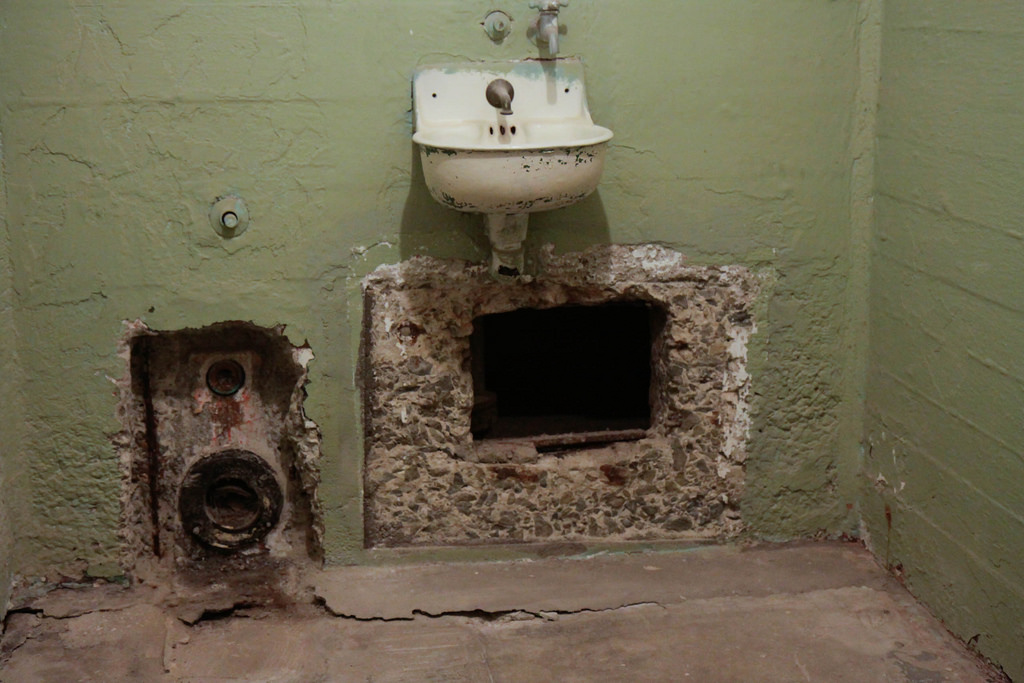The Alcatraz Federal Penitentiary is located on an island in the San Francisco Bay. It was thought to be an impenetrable fortress, surrounded on all sides by cliffs and ice cold water. Although many prisoners attempted to escape, they were either caught or froze to death. That’s what makes the successful prison escape of three convicts such a memorable and mysterious event. The details of their escape have remained largely unknown.. Until now. New evidence has materialized over 50 years after the event.
The Rock

Built in 1860 as a military citadel and prison, Alcatraz was a federal prison that had a reputation as the toughest place to serve time. The facility sits on a rocky island in the Bay, which makes it difficult to reach or escape. In 1775, the island was discovered by a Spanish explorer, who named it La Isla de los Alcatraces, or Island of the Pelicans, because of the large population of sea birds that lived among the rocks. Known as “the Rock,” Alcatraz was first an Army prison that housed Confederate soldiers during the Civil War. In 1933, the federal government took over the prison and dedicated it to incarcerating the worst criminals. The island’s distance from the mainland and the extremely cold waters were thought to make the prison impervious to escape attempts.
Inescapable

The prison was a federal penitentiary from 1934 to 1963. The prison authorities made it a maximum-security level institution, with an astonishing one guard for every three prisoners. Authorities sent the so-called “worst of the worst” to the Rock, where they would be held in single cells with very few privileges. Mobsters like Al Capone and killers like Robert “Birdman” Stroud both served time at the Rock.

Of the 36 men who tried to escape from Alcatraz, 23 were recaptured, six were shot and killed, two drowned, and five are considered missing and presumed drowned. According to prison officials, no prisoner escaped until June 11, 1962, when three convicts turned up missing.
Frank Morris

Frank Lee Morris, a career criminal who was highly intelligent, was born in Washington, D.C. on Sept. 1, 1926. Morris was an orphan whose youth was spent being shuffled between foster homes. Morris’ life of crime began when he only 13. He was convicted of dozens of crimes ranging from burglary to armed robbery to possession of drugs. In 1960, police caught Morris committing a burglary. He was sent to Alcatraz and given inmate number AZ1441.
The Anglin Brothers

Morris had two cellmates, Alfred and John Anglin. The brothers were from a family of 13 children who lived in Donalsonville, Georgia in 1930. Their parents were itinerant farmers who were constantly moving across the United States to work on seasonal farms.
The brothers, however, took a different path. They started robbing banks and other businesses in the early 1950s, choosing targets that were closed so that no people were present to get hurt (or witness the crimes). Georgia police captured the Anglin brothers and sent them to prison. But John and Alfred repeatedly tried to escape from state prison. As a result, Georgia sent the brothers to Alcatraz in 1960.
Allen West

A fourth man, Allen Clayton West, was a car thief. He was convicted of theft in 1955 and sent to Atlanta Penitentiary, then transferred to Florida State Prison. However, like the Anglin brothers, West frequently tried to escape. This resulted in his transfer to Alcatraz in 1957. He was given inmate number AZ1335.

Although West intended to flee with the other three, he was not able to remove the ventilator grill in his cell fast enough to join their escape. After Alcatraz was closed, West was transferred to several other prisons to serve out his term. However, after his release, he was convicted again of larceny. While serving his sentence at Florida State Prison, he stabbed and killed a man. West was given a life sentence. He died in 1979 of acute peritonitis.
Plan
The escape plan was engineered by Morris, who was unusually intelligent. The four men spent months plotting their escape. They dug through ventilation shafts within their cells. They planted decoys that made it appear like they were still in their cells. Once the decoys were ready, the plan was to escape in the middle of the night and crawl down to the bay, where they had a raft ready to sail away. The plan seemed easy, but when it came to escaping from the Rock, nothing was ever that simple.
Decoys

The four men needed dummy decoys because the guards did bed checks throughout the night. Morris and his three accomplices made papier-mâché heads of themselves, using a mixture of soap and toilet paper. To give their dummies a realistic appearance, they stole paint from the maintenance shop and hair from the barbershop floor. They stuffed clothing under the blankets so it looked like they were asleep with their heads on the pillows.
Digging

The most physical part of the plan involved digging holes through the ventilation ducts in their cells. To accomplish this, the men waited until music hour, a recreation time during the early evening when inmates were permitted to play instruments or sing.

In order to do this backbreaking digging and drilling, the men improvised, using old saw blades, spoons from the commissary and even an ingeniously created drill made from a vacuum cleaner motor. They hid their work by using cardboard on the walls. Eventually, the holes were wide enough for the men to crawl through.
A Problem

The prisoners were about to leave their cells for the last time when a problem arose. West couldn’t quite get through the hole in his wall. The other three men couldn’t afford to lose any time, so they left him behind. West was the first man to bring up the idea of an escape, but his co-conspirators ditched him anyway. West told prison authorities that he was involved in the escape plan, but he didn’t rat out his co-conspirators. He never divulged the complete plan and took their secrets to his grave.
The Climb

Once the men were in the ventilation ducts, they made their way into a utility corridor which was unguarded and located just behind the cell tier. In the utility corridor, Morris, John and Alfred climbed the ventilation shaft all the way up to the roof. They made a loud crash as they broke though the shaft, but guards did not immediately investigate. The three men then slid down a kitchen vent pipe to the ground – a 50-foot descent. They had almost made it. But the escapees still needed to climb a 12-foot barbed-wire fence that surrounded the perimeter of the prison.
The Getaway Raft

Unlike the other escapees, the men did not attempt to swim in the frigid waters. Back in prison, they had carefully collected a large number of donated and stolen materials, including over 50 raincoats. The prisoners used the raincoats as life preservers and then built themselves a 6-by-14 foot rubber raft.

The inmates’ innovative strategy included using heat from the prison’s steam pipes to seal the raft together. They even made wooden paddles and stole a small concertina from another inmate, which was used to inflate the raft. At around 10 p.m., they used the concertina to blow up the raft near the northeast shoreline. They entered the water near the power plant, which was a blind spot in the extensive network of searchlights and gun towers.
Scanning and Searching the Bay

The next morning, guards discovered that the three men were missing. They searched the entire prison and grounds, triggering one of the largest manhunters ever. The guards found the ventilation holes, but there was no sign of the escapees. Guards searched the entire island and nearby Angel Island, looking for any possible sign that the men had been there or perished in the icy waters. After much searching, the scent went cold. The men appeared to have escaped.
No Bodies

During the first 24 hours after their escape, the assumption was that the men would not have survived the water. Authorities did not find the raft, clothing or any other evidence. Authorities theorized that an outgoing tide probably occurred just after the men made their daring escape, dragging them toward the Pacific Ocean. However, there were some doubts about whether that meant the prisoners drowned. The Anglin brothers in particular were highly skilled swimmers. They had spent summers swimming in the cold lakes of Wisconsin, so they were not intimidated by the San Francisco Bay.
A Few Signs

During the manhunt, it became obvious that the dummy plan had worked just like the men had intended. It had given them several hours head start. Still, the government undertook an extensive sea, land and air search, utilizing federal law enforcement, state and military police agencies for 10 days. Then, four days after the escape, the Coast Guard retrieved a paddle that was floating about 220 yards from Angel Island. In the same general area, men working on a boat found a wallet that was wrapped in plastic. This was the strongest clue yet – it contained a list of people, their photographs, addresses and phone numbers, which seemed to be people on the outside who were willing to help the inmates.
Rediscovered Evidence

Then on June 21, the trail seemed to heat up. Law enforcement found the torn shreds of raincoat on the Angel Island beach. Believing they were close to finding the men, the Coast Guard and U.S. Marshals intensified their efforts. The very next day, a prison boat found a life jacket that was made from the raincoat material, just 50 yards from Alcatraz island. No bodies washed ashore, but several months later, more evidence emerged.
A Body

One day a ship from Norway was sailing through the bay when its workers spotted a floating body. It was about 20 miles past the Golden Gate Bridge. Initially, the Norwegian ship ignored the body, but once they heard about the escape, they reported it to the authorities. Although they hadn’t been able to retrieve the body, the ship’s crew described a man that looked a lot like Frank Morris. If this was indeed Morris, then what happened to the Anglin brothers?
Anglin Survived?

A day after the escape, someone claiming to be John Anglin called a San Francisco law firm that often represented Alcatraz inmates. The man said “I’m John Anglin. Do you know who I am?… No? Read the newspaper.” The alleged Anglin then hung up without saying more. One of the prison inmates, Clarence Carnes, said that he received a postcard that he believed was from the Anglins. It read “Goin’ Fishin’.” According to Carnes, these words were code for a successful escape.
Outside Accomplices

Many believe that the prisoners could not have planned the escape without help from outside. A fellow inmate, Ellsworth “Bumpy” Johnson, was a mafia kingpin from Harlem. He apparently gave the inmates the name of a person who could arrange for a boat to pick them up on Angel Island. Carnes said the boat took the convicts to Pier 13, which is located in the Hunter’s Point district of San Francisco. However, no one knew whether they had made it to the rendezvous point.
New Evidence

Almost 30 years after the escape, a former inmate came forward to claim he had also helped the men plan their escape. In 1993, Thomas Kent told the TV series America’s Most Wanted that Clarence’s girlfriend agreed to meet the men on the mainland. Her plan was to help drive them to Mexico. Kent said he would have gone with the men, but he was unable to swim.
The Anglin Family Says The Anglins Lived

In 2012, the family of escapees John and Alfred presented evidence they had collected, which suggested the two men made it to South America. The year 2012 was also the 50th anniversary of the escape attempt. Their sisters and nephews said that right after the escape, they got a phone call from San Francisco. The caller merely said “This is John Anglin” and hung up. Later in 1962, the family received a Christmas card, stating “To Mother, from John. Merry Christmas.”

In 2015, the family worked with the History Channel to present and verify the evidence they had gathered. Many Christmas cards were examined. A handwriting expert concluded that they contained the brothers’ handwriting, but none of the envelopes had a postmarked stamp. Family friend Fred Brizzi said he ran into the brothers in Rio de Janeiro Brazil, in 1975. The Anglins invited Brizzi back to their farm and they took photos together, which Brizzi gave the family. An expert who examined the pictures concluded that they were in fact taken in 1975 and that the two men were the Anglins.
Casting Doubts

The FBI cast doubts on the History Channel’s conclusion. Their expert said the men in the photographs could not have been the Anglins. The FBI expert claimed the sunglasses worn by the men in the photo hindered their effort to make a definitive identification. They also said that Brizzi was a known conman and drug smuggler. The FBI said they had received information that the brothers could be in Rio as early as 1965, but their agents could find no sign of the men.
Deathbed Confession

Robert Anglin, another sibling, said on his deathbed that he had remained in contact with his brothers from 1963 until 1987. Robert died in 2010. Although the family announced that they would go to Brazil in search of the brothers, who would be in their 80s, the FBI warned them that it was still an open case that was being investigated by Interpol. The FBI used a DNA sample from the Anglin family to determine that the body the Norwegians had discovered floating in the bay was not Clarence or John.
Alternate Theory

Brizzi said that when the trio went to the lake by the farm, they attached a rope to a rudder, and then laid on it. He asked the men if that’s how they escaped from Alcatraz and they said yes. This led some to believe they may have been towed by a passenger ferry. The guards reported that 120 feet of electrical wire went missing from the dock right after the escape.
Historic Site

In 1964, Alcatraz was closed because of the incredible expense of running such a remote prison. It is still a popular tourist destination in the Bay Area. Tourists can visit the grounds and tour the cells, hearing the stories of the men who were housed at Alcatraz, including the three escapees. Paranormal investigators believe the place is haunted, while crime researchers continue to visit in hopes of unlocking more secrets about the prison and its former inmates. The many mysteries of Alcatraz ensure that the island prison will remain popular for years to come.






